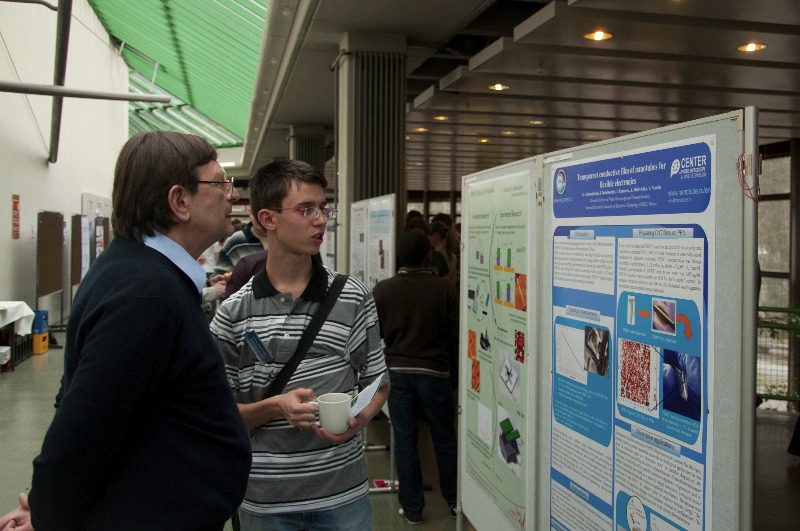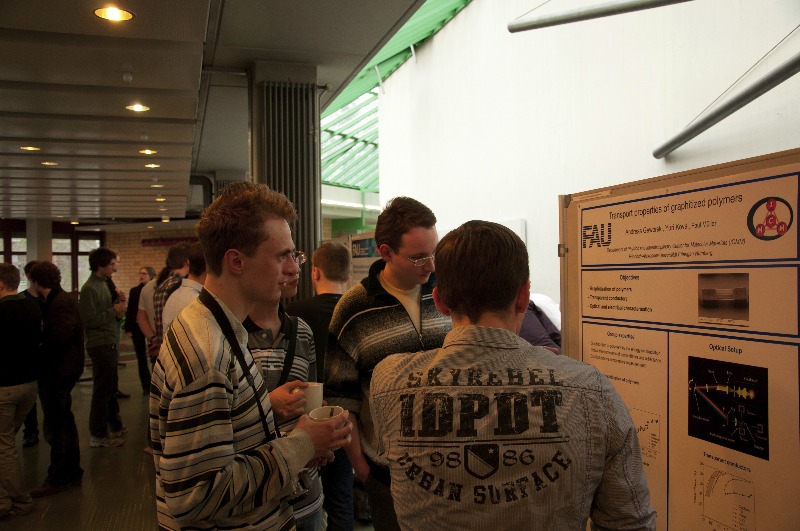Quantum physics and nanoelectronics chair post-graduate and master students took part in scientific school-conference “Cutting-edge Research on Graphene” (Erlangen, Germany)
 In the beginning of April the delegation of Scientific-Educational Center “Probe Microscopy and Nanotechnology” employees visited town Erlangen (Germany) and took part in scientific school-conference “Cutting-edge Research on Graphene”. The event took place and was organized by Friedrich-Alexander-Universität (FAU) situated in Erlangen.
In the beginning of April the delegation of Scientific-Educational Center “Probe Microscopy and Nanotechnology” employees visited town Erlangen (Germany) and took part in scientific school-conference “Cutting-edge Research on Graphene”. The event took place and was organized by Friedrich-Alexander-Universität (FAU) situated in Erlangen.
Probably, this trip could be accounted a return visit, as in May 2012 FAU’s representatives travelled to Zelenograd and visited our Alma Mater MIET first. During this visit the delegation took a closer look at the researches conducted in the chairs of biomedical systems, materials and processes of solid-state electronics and also in SEC “Probe Microscopy and Nanotechnology”. Our universities have been in tight partnership and are fostering collaboration for years, while simultaneously taking part in Moscow-Bavarian joint student schools and scientific conferences on biomedical researches.
 And now, at last, our mutual interests are spreading further to such a perspective material – graphene. In general, FAU school lecture program was devoted mainly to this material. Organization committee solved the issue with lecture materials with german-like love for orderliness. First lectures reviewing graphene properties gradually turned to the methods of fabrication and to practical realization of electronic structures based on graphene. The majority of lectors were university employees, what in its turn influenced the reports themes and slightly the poster session after the lectures. It is worth mentioning that Friedrich-Alexander-Universität is one of the leading centers of graphene on silicon carbide (SiC) researches in Europe. It is acknowledged that this method of fabrication is expensive; however, the graphene material obtained by this method possesses outstanding properties. Formation of micro- and nanoelectronics elements on the basis of graphene, is mainly aimed at the creation of various sensors and NEMS-structures.
And now, at last, our mutual interests are spreading further to such a perspective material – graphene. In general, FAU school lecture program was devoted mainly to this material. Organization committee solved the issue with lecture materials with german-like love for orderliness. First lectures reviewing graphene properties gradually turned to the methods of fabrication and to practical realization of electronic structures based on graphene. The majority of lectors were university employees, what in its turn influenced the reports themes and slightly the poster session after the lectures. It is worth mentioning that Friedrich-Alexander-Universität is one of the leading centers of graphene on silicon carbide (SiC) researches in Europe. It is acknowledged that this method of fabrication is expensive; however, the graphene material obtained by this method possesses outstanding properties. Formation of micro- and nanoelectronics elements on the basis of graphene, is mainly aimed at the creation of various sensors and NEMS-structures.
 Only in the evenings after the tiring day filled with scientific information the participants were able to feel the atmosphere of the university town. Frankly speaking, strolling along the paved with large brick streets of the town one starts to realize why the inhabitants call this place town-university. Nowadays, Friedrich-Alexander-Universität is the biggest in Bavaria and the second biggest university in Germany. It studies the large variety of different subjects. The number of students studying there is about 23 thousands, so every fifth resident of the town is a student. Also, during World War II Siemens company has moved its headquarters with the majority of production facilities from Berlin to Erlangen, fearing bombings during the city siege. By that time, Erlangen had already quartered one Siemens division for medical technics –
Only in the evenings after the tiring day filled with scientific information the participants were able to feel the atmosphere of the university town. Frankly speaking, strolling along the paved with large brick streets of the town one starts to realize why the inhabitants call this place town-university. Nowadays, Friedrich-Alexander-Universität is the biggest in Bavaria and the second biggest university in Germany. It studies the large variety of different subjects. The number of students studying there is about 23 thousands, so every fifth resident of the town is a student. Also, during World War II Siemens company has moved its headquarters with the majority of production facilities from Berlin to Erlangen, fearing bombings during the city siege. By that time, Erlangen had already quartered one Siemens division for medical technics –
Siemens-Reiniger. Today Siemens employs over 31% of all the labor force in the town.
Thus, the neighborhood of university as the specialists supply with such a huge concern as Siemens entitles one to say that Erlangen claims to be unofficial capital of medical equipment and medicine, it is even called “Medical Valley”.